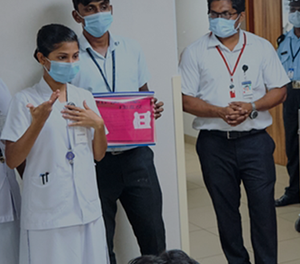

The culture of Neuroanaesthesia as a speciality developed in association with progressive and dynamic neurosurgeons all over the world and this was no exception in Christian Medical College(CMC), Vellore. Neurosurgery as a separate entity was started by the renowned Dr Jacob Chandy in 1949 and the interest in Neuroanaesthesia was palpable from the very early days of Neurosurgery.
The Anesthesiology Department initially had anesthesiologists trained overseas in this field who visited them periodically. Dr Saro Devanandan, Former Professor and Head of the Department of Anesthesiology in CMC, Vellore trained at the Montreal Neurological Institute and was involved with neuroanesthesia for almost 3 decades. Following her, Dr Grace Korula, Former Professor and Head of the Anesthesiology in CMC, Vellore who had completed her Fellowship in Neuroanaesthesia from Ireland was instrumental in the development of Neuroanaesthesia. Neuroanaesthesia as a speciality was recognised officially by the Indian Society of Neuroanaesthesia and Critical Care in 1999 and the second Annual Conference was held in CMC , Vellore in the year 2000. The Postdoctoral Fellowship in Neuroanaesthesia was started in 2008 and was affiliated with The TN Dr MGR Medical University in 2011. The Medical Council of India has granted permission to start the DM in Neuroanaesthesia under its purview with affiliation to The TN Dr MGR Medical University in 2020.
Intraoperative Neurophysiological Monitoring was first started in CMC, Vellore and anaesthesiologists interested in intraoperative neurophysiological monitoring often visited the department to train in specialised anaesthetic Management required to facilitate neurophysiological monitoring.
Research has always been given a strong emphasis in the department and the department conducts excellent CMEs and workshops periodically.
Anaesthesia for the following surgeries
Pre Anaesthesia Facility
All patients undergoing Elective neurosurgical Procedures are seen in this clinic by a Consultant 1-5 days before surgery. Complex procedure are discussed in multidisciplinary meeting for better preop optimisation.
Procedures are done apart from the routine GA/ line placement
DM in Neuroanaesthesia
Duration of the Course: 3 years, MCI Approved and affiliated to “The Tamil Nadu Dr M.G.R Medical University, TN.”
Eligibility: MD/DNB Anaesthesia. NEET Superspecialty Examination
No. of seats: Two
Overview of Training Programmes
The Department of Neuroanaesthesia offers opportunities for those interested in advanced neuroanesthesia training. The Neurosciences department does about 3000 neurosurgical procedures per year with an extensive range of cases which include tumour surgery, seizure surgery, transnasal trans-sphenoidal pituitary surgery, intracranial aneurysms and other vascular procedures, spinal instrumentations, neuro-trauma, paediatric neurosurgery and awake craniotomy. The neurosciences department is the pioneer in the field of intraoperative neuromonitoring and evoked potential monitoring in India.
The three-year DM course in neuroanesthesia is open to those who have finished an M.D. or DNB in Anaesthesiology. This course involves training in the state-of-the-art newer techniques of anaesthesia and intraoperative neuro monitoring for neurosurgical procedures.
The trainees rotate through neurosurgery operation theatres, Neuro intensive care and Neurotrauma ICU. They are exposed to Neuro radiology and undergo a short training in intraoperative neuromonitoring. There is ample opportunity for hands-on training in procedures such as arterial cannulations, ultrasound and ECG-guided central venous cannulations, fibreoptic and video laryngoscopic intubations, Scalp block, Fascial plane blocks, and Lumbar drain insertion. Trainees are exposed to POCUS, Transcranial Doppler, intracranial pressure monitoring, Depth of anaesthesia monitoring BIS/Entropy/Patient State Index (Masimo) techniques, NIRS, Pupillometry, and Cardiac output monitoring.
They also get an opportunity to train in EEG and other neurophysiology monitoring such as SSEP/MEP/BAER monitoring. The trainees have exposure to anaesthesia for stereotactic procedures, MRI, interventional and other neuroradiologic procedures. They are also trained in anaesthesia for emergency neurosurgery and neuro trauma. There is ample opportunity for research and trainees are encouraged to present scientific work in national conferences and publish their work in peer-reviewed journals.
Department of Neuroanaesthesiology
Christian Medical College,
A602, Ranipet Campus,
Tamilnadu, India
Pincode – 632004.
Email us :
neuroanaesthesia@cmcvellore.ac.in
004172224632
Mon-Fri: 8 am to 4.30 pm
( Sat : 8 am to 12:30 pm)